Istanbul (Turkish: İstanbul) is the largest city in Turkey, serving as the country's economic, cultural and historic hub. The city straddles the Bosporus Strait, lying in both Europe and Asia, and has a population of over 15 million residents, comprising 19% of the population of Turkey. Istanbul is the most populous European city and the world's 15th largest city.
The city was founded as Byzantium (Greek: Βυζάντιον, Byzantion) in the 7th century BCE by Greek settlers from Megara. In 330 CE, the Roman emperor Constantine the Great made it his imperial capital, renaming it first as New Rome (Greek: Νέα Ῥώμη, Ne...Read more
Istanbul (Turkish: İstanbul) is the largest city in Turkey, serving as the country's economic, cultural and historic hub. The city straddles the Bosporus Strait, lying in both Europe and Asia, and has a population of over 15 million residents, comprising 19% of the population of Turkey. Istanbul is the most populous European city and the world's 15th largest city.
The city was founded as Byzantium (Greek: Βυζάντιον, Byzantion) in the 7th century BCE by Greek settlers from Megara. In 330 CE, the Roman emperor Constantine the Great made it his imperial capital, renaming it first as New Rome (Greek: Νέα Ῥώμη, Nea Rhomē; Latin: Nova Roma) and then as Constantinople (Constantinopolis) after himself. In 1930, the city's name was officially changed to Istanbul, the Turkish rendering of εἰς τὴν Πόλιν (romanized: eis tḕn Pólin; 'to the City'), the appellation Greek speakers used since the 11th century to colloquially refer to the city.
The city served as an imperial capital for almost 1600 years: during the Roman/Byzantine (330–1204), Latin (1204–1261), late Byzantine (1261–1453), and Ottoman (1453–1922) empires. The city grew in size and influence, eventually becoming a beacon of the Silk Road and one of the most important cities in history. The city played a key role in the advancement of Christianity during Roman/Byzantine times, hosting four of the first seven ecumenical councils before its transformation to an Islamic stronghold following the Fall of Constantinople in 1453 CE—especially after becoming the seat of the Ottoman Caliphate in 1517. In 1923, after the Turkish War of Independence, Ankara replaced the city as the capital of the newly formed Republic of Turkey.
Istanbul has surpassed London and Dubai to become the most visited city in the world, with more than 20 million foreign visitors in 2023. The historic centre of Istanbul is a UNESCO World Heritage Site, and the city hosts the headquarters of numerous Turkish companies, accounting for more than thirty percent of the country's economy.
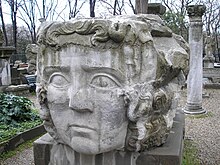 This large keystone might have belonged to a triumphal arch at the Forum of Constantine (present-day Çemberlitaş)[1]
This large keystone might have belonged to a triumphal arch at the Forum of Constantine (present-day Çemberlitaş)[1]Neolithic artifacts, uncovered by archeologists at the beginning of the 21st century, indicate that Istanbul's historic peninsula was settled as far back as the 6th millennium BCE.[2] That early settlement, important in the spread of the Neolithic Revolution from the Near East to Europe, lasted for almost a millennium before being inundated by rising water levels.[3][2][4][5] The first human settlement on the Asian side, the Fikirtepe mound, is from the Copper Age period, with artifacts dating from 5500 to 3500 BCE,[6] On the European side, near the point of the peninsula (Sarayburnu), there was a Thracian settlement during the early 1st millennium BCE. Modern authors have linked it to the Thracian toponym Lygos,[7] mentioned by Pliny the Elder as an earlier name for the site of Byzantium.[8]
The history of the city proper begins around 660 BCE,[9][10][a] when Greek settlers from Megara established Byzantium on the European side of the Bosporus. The settlers built an acropolis adjacent to the Golden Horn on the site of the early Thracian settlements, fueling the nascent city's economy.[16] The city experienced a brief period of Persian rule at the turn of the 5th century BCE, but the Greeks recaptured it during the Greco-Persian Wars.[17] Byzantium then continued as part of the Athenian League and its successor, the Second Athenian League, before gaining independence in 355 BCE.[18] Long allied with the Romans, Byzantium officially became a part of the Roman Empire in 73 CE.[19] Byzantium's decision to side with the Roman usurper Pescennius Niger against Emperor Septimius Severus cost it dearly; by the time it surrendered at the end of 195 CE, two years of siege had left the city devastated.[20] Five years later, Severus began to rebuild Byzantium, and the city regained—and, by some accounts, surpassed—its previous prosperity.[21]
Rise and fall of Constantinople and the Byzantine Empire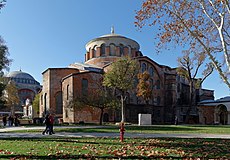
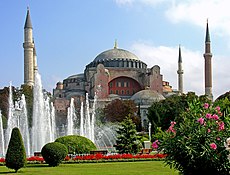
Constantine the Great effectively became the emperor of the whole of the Roman Empire in September 324.[22] Two months later, he laid out the plans for a new, Christian city to replace Byzantium. As the eastern capital of the empire, the city was named Nova Roma; most called it Constantinople, a name that persisted into the 20th century.[23] On 11 May 330, Constantinople was proclaimed the capital of the Roman Empire, which was later permanently divided between the two sons of Theodosius I upon his death on 17 January 395, when the city became the capital of the Eastern Roman (Byzantine) Empire.[24]
The establishment of Constantinople was one of Constantine's most lasting accomplishments, shifting Roman power eastward as the city became a center of Greek culture and Christianity.[24][25] Numerous churches were built across the city, including Hagia Sophia which was built during the reign of Justinian the Great and remained the world's largest cathedral for a thousand years.[26] Constantine also undertook a major renovation and expansion of the Hippodrome of Constantinople; accommodating tens of thousands of spectators, the hippodrome became central to civic life and, in the 5th and 6th centuries, the center of episodes of unrest, including the Nika riots.[27][28] Constantinople's location also ensured its existence would stand the test of time; for many centuries, its walls and seafront protected Europe against invaders from the east and the advance of Islam.[25] During most of the Middle Ages, the latter part of the Byzantine era, Constantinople was the largest and wealthiest city on the European continent and at times the largest in the world.[29][30] Constantinople is generally considered to be the center and the "cradle of Orthodox Christian civilization".[31][32]
Constantinople began to decline continuously after the end of the reign of Basil II in 1025. The Fourth Crusade was diverted from its purpose in 1204, and the city was sacked and pillaged by the crusaders.[33] They established the Latin Empire in place of the Orthodox Byzantine Empire.[34] Hagia Sophia was converted to a Catholic church in 1204. The Byzantine Empire was restored, albeit weakened, in 1261.[35] Constantinople's churches, defenses, and basic services were in disrepair,[36] and its population had dwindled to a hundred thousand from half a million during the 8th century.[b] After the reconquest of 1261, however, some of the city's monuments were restored, and some, like the two Deesis mosaics in Hagia Sophia and Kariye, were created.[37]
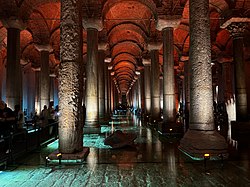 The 6th century Basilica Cistern was built by Justinian the Great.
The 6th century Basilica Cistern was built by Justinian the Great.Various economic and military policies instituted by Andronikos II, such as the reduction of military forces, weakened the empire and left it vulnerable to attack.[38] In the mid-14th-century, the Ottoman Turks began a strategy of gradually taking smaller towns and cities, cutting off Constantinople's supply routes and strangling it slowly.[39] On 29 May 1453, after an eight-week siege (during which the last Roman emperor, Constantine XI, was killed), Sultan Mehmed II "the Conqueror" captured Constantinople.
Ottoman EmpireSultan Mehmed declared Constantinople the new capital of the Ottoman Empire. Hours after the fall of the city, the sultan rode to the Hagia Sophia and summoned an imam to proclaim the Islamic creed, converting the grand cathedral into an imperial mosque due to the city's refusal to surrender peacefully.[40] Mehmed declared himself as the new Kayser-i Rûm (the Ottoman Turkish equivalent of the Caesar of Rome) and the Ottoman state was reorganized into an empire.[41][42]
 Map of Istanbul in the 16th century by the Ottoman polymath Matrakçı Nasuh
Map of Istanbul in the 16th century by the Ottoman polymath Matrakçı NasuhFollowing the capture of Constantinople,[c] Mehmed II immediately set out to revitalize the city. Cognizant that revitalization would fail without the repopulation of the city, Mehmed II welcomed everyone–foreigners, criminals, and runaways– showing extraordinary openness and willingness to incorporate outsiders that came to define Ottoman political culture.[44] He also invited people from all over Europe to his capital, creating a cosmopolitan society that persisted through much of the Ottoman period.[45] Revitalizing Istanbul also required a massive program of restorations, of everything from roads to aqueducts.[46] Like many monarchs before and since, Mehmed II transformed Istanbul's urban landscape with wholesale redevelopment of the city center.[47] There was a huge new palace to rival, if not overshadow, the old one, a new covered market (still standing as the Grand Bazaar), porticoes, pavilions, walkways, as well as more than a dozen new mosques.[46] Mehmed II turned the ramshackle old town into something that looked like an imperial capital.[47]
Social hierarchy was ignored by the rampant plague, which killed the rich and the poor alike in the 16th century.[48] Money could not protect the rich from all the discomforts and harsher sides of Istanbul.[48] Although the Sultan lived at a safe remove from the masses, and the wealthy and poor tended to live side by side, for the most part Istanbul was not zoned as modern cities are.[48] Opulent houses shared the same streets and districts with tiny hovels.[48] Those rich enough to have secluded country properties had a chance of escaping the periodic epidemics of sickness that blighted Istanbul.[48]
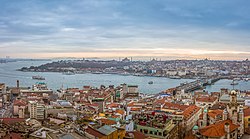 View of the Golden Horn and the Seraglio Point from Galata Tower
View of the Golden Horn and the Seraglio Point from Galata TowerThe Ottoman Dynasty claimed the status of caliphate in 1517, with Constantinople remaining the capital of this last caliphate for four centuries.[49] Suleiman the Magnificent's reign from 1520 to 1566 was a period of especially great artistic and architectural achievement; chief architect Mimar Sinan designed several iconic buildings in the city, while Ottoman arts of ceramics, stained glass, calligraphy, and miniature flourished.[50] The population of Constantinople was 570,000 by the end of the 18th century.[51]
A period of rebellion at the start of the 19th century led to the rise of the progressive Sultan Mahmud II and eventually to the Tanzimat period, which produced political reforms and allowed new technology to be introduced to the city.[52] Bridges across the Golden Horn were constructed during this period,[53] and Constantinople was connected to the rest of the European railway network in the 1880s.[54] Modern facilities, such as a water supply network, electricity, telephones, and trams, were gradually introduced to Constantinople over the following decades, although later than to other European cities.[55] The modernization efforts were not enough to forestall the decline of the Ottoman Empire.[56]
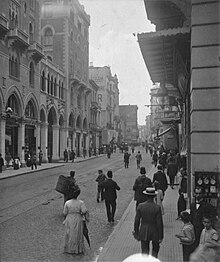 Cadde-i Kebir (Grande Rue de Péra) in the Beyoğlu (Pera) district, 1912. The entrance of the Church of St. Anthony of Padua is seen at left. A Nestlé advertisement is visible on a building in the background.
Cadde-i Kebir (Grande Rue de Péra) in the Beyoğlu (Pera) district, 1912. The entrance of the Church of St. Anthony of Padua is seen at left. A Nestlé advertisement is visible on a building in the background.With the Young Turk Revolution in 1908, the Ottoman Parliament, closed since 14 February 1878, was reopened 30 years later on 23 July 1908, which marked the beginning of the Second Constitutional Era.[57] The civil strife and political uncertainties in the Ottoman Empire during the months after the revolution encouraged Austria-Hungary to annex Bosnia and Bulgaria to declare its independence in a jointly coordinated move on 5 October 1908. Sultan Abdul Hamid II was deposed in 1909, following the counter-revolution attempt known as the 31 March incident. A series of wars in the early 20th century, such as the Italo-Turkish War (1911–1912) and the Balkan Wars (1912–1913), plagued the ailing empire's capital and resulted in the 1913 Ottoman coup d'état, which brought the regime of the Three Pashas.[58]
The Ottoman Empire joined World War I (1914–1918) on the side of the Central Powers and was ultimately defeated. The deportation of Armenian intellectuals on 24 April 1915 was among the major events which marked the start of the Armenian genocide during WWI.[59] Due to Ottoman and Turkish policies of Turkification and ethnic cleansing, the city's Christian population declined from 450,000 to 240,000 between 1914 and 1927.[60] The Armistice of Mudros was signed on 30 October 1918 and the Allies occupied Constantinople on 13 November 1918. The Ottoman Parliament was dissolved by the Allies on 11 April 1920 and the Ottoman delegation led by Damat Ferid Pasha was forced to sign the Treaty of Sèvres on 10 August 1920.[citation needed]
Following the Turkish War of Independence (1919–1922), the Grand National Assembly of Turkey in Ankara abolished the Sultanate on 1 November 1922, and the last Ottoman Sultan, Mehmed VI, was declared persona non grata. Leaving aboard the British warship HMS Malaya on 17 November 1922, he went into exile and died in Sanremo, Italy, on 16 May 1926.
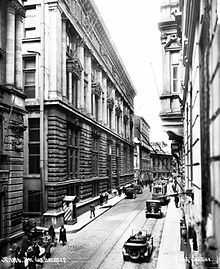 A view of Bankalar Caddesi (Banks Street) in the late 1920s. Completed in 1892, the Ottoman Bank headquarters is seen at left. In 1995 the Istanbul Stock Exchange moved to İstinye, while numerous Turkish banks have moved to Levent and Maslak.[61]
A view of Bankalar Caddesi (Banks Street) in the late 1920s. Completed in 1892, the Ottoman Bank headquarters is seen at left. In 1995 the Istanbul Stock Exchange moved to İstinye, while numerous Turkish banks have moved to Levent and Maslak.[61]The Treaty of Lausanne was signed on 24 July 1923, and the occupation of Constantinople ended with the departure of the last forces of the Allies from the city on 4 October 1923.[62] Turkish forces of the Ankara government, commanded by Şükrü Naili Pasha (3rd Corps), entered the city with a ceremony on 6 October 1923, which has been marked as the Liberation Day of Istanbul (Turkish: İstanbul'un Kurtuluşu) and is commemorated every year on its anniversary.[62]
Turkish RepublicOn 29 October 1923 the Grand National Assembly of Turkey declared the establishment of the Turkish Republic, with Ankara as its capital. Mustafa Kemal Atatürk became the Republic's first President.[63][64]
A 1942 wealth tax assessed mainly on non-Muslims led to the transfer or liquidation of many businesses owned by religious minorities.[65] From the late 1940s and early 1950s, Istanbul underwent great structural change, as new public squares, boulevards, and avenues were constructed throughout the city, sometimes at the expense of historical buildings.[66] The population of Istanbul began to rapidly increase in the 1970s, as people from Anatolia migrated to the city to find employment in the many new factories that were built on the outskirts of the sprawling metropolis. This sudden, sharp rise in the city's population caused a large demand for housing, and many previously outlying villages and forests became engulfed into the metropolitan area of Istanbul.[67]
"On leaving the Dardanelles we come to the Bay of Casthenes, ... and the promontory of the Golden Horn, on which is the town of Byzantium, a free state, formerly called Lygos; it is 711 miles from Durazzo, ..."". Archived from the original on 1 January 2017. Retrieved 21 June 2015. ^ Cite error: The named reference Britannica-Istanbul was invoked but never defined (see the help page). ^ Bloom & Blair 2009, p. 1. ^ Herodotus Histories 4.144, translated in De Sélincourt 2003, p. 288 ^ a b Isaac 1986, p. 199. ^ Roebuck 1959, p. 119, also as mentioned in Isaac 1986, p. 199 ^ Lister 1979, p. 35. ^ Freely 1996, p. 10. ^ Çelik 1993, p. 11. ^ De Souza 2003, p. 88. ^ Freely 1996, p. 20. ^ Freely 1996, p. 22. ^ Grant 1996, pp. 8–10. ^ Limberis 1994, pp. 11–12. ^ Barnes 1981, p. 77 ^ Barnes 1981, p. 212 ^ a b Barnes 1981, p. 222 ^ a b Gregory 2010, p. 63 ^ Klimczuk & Warner 2009, p. 171 ^ Dash, Mike (2 March 2012). "Blue Versus Green: Rocking the Byzantine Empire". Smithsonian Magazine. The Smithsonian Institution. Archived from the original on 5 August 2012. Retrieved 30 July 2012. ^ Dahmus 1995, p. 117 ^ Cantor 1994, p. 226 ^ Morris 2010, pp. 109–18 ^ Parry, Ken (2009). Christianity: Religions of the World. Infobase Publishing. p. 139. ISBN 9781438106397. ^ Parry, Ken (2010). The Blackwell Companion to Eastern Christianity. John Wiley & Sons. p. 368. ISBN 9781444333619. ^ Gregory 2010, pp. 324–29. ^ Gregory 2010, pp. 330–333. ^ Gregory 2010, p. 340. ^ Gregory 2010, pp. 341–342. ^ "Deesis Mosaic". Hagia Sophia. 5 November 2017. Retrieved 31 January 2021. ^ Reinert 2002, pp. 258–260. ^ Baynes 1949, p. 47. ^ Gregory 2010, pp. 394–399. ^ Béhar 1999, p. 38. ^ Bideleux & Jeffries 1998, p. 71. ^ Edhem, Eldem. "Istanbul." In: Ágoston, Gábor and Bruce Alan Masters. Encyclopedia of the Ottoman Empire. Infobase Publishing, 21 May 2010. ISBN 1-4381-1025-1, ISBN 9781438110257. Start and CITED: p. 286. "Originally, the name Istanbul referred only to[...]in the 18th century." and "For the duration of Ottoman rule, western sources continued to refer to the city as Constantinople, reserving the name Stamboul for the walled city." and "Today the use of the name[...]is often deemed politically incorrect[...]by most Turks." // (entry ends, with author named, on p. 290) ^ Inalcik, Halil. "The Policy of Mehmed II toward the Greek Population of Istanbul and the Byzantine Buildings of the City." Dumbarton Oaks Papers 23, (1969): 229–49. p. 236 ^ Holt, Lambton & Lewis 1977, pp. 306–07 ^ a b Hughes, Bettany (2018). Istanbul: A Tale of Three Cities. London. ISBN 978-1-78022-473-2.{{cite book}}: CS1 maint: location missing publisher (link) ^ a b Madden, Thomas F. (7 November 2017). Istanbul: City of Majesty at the Crossroads of the World. New York. ISBN 978-0-14-312969-1.{{cite book}}: CS1 maint: location missing publisher (link) ^ a b c d e Byrne, Joseph Patrick (2012). Encyclopedia of the Black Death. Santa Barbara, CA. ISBN 978-1-59884-253-1.{{cite book}}: CS1 maint: location missing publisher (link) ^ Cite error: The named reference maag1145 was invoked but never defined (see the help page). ^ Holt, Lambton & Lewis 1977, pp. 735–36 ^ Chandler, Tertius; Fox, Gerald (1974). 3000 Years of Urban Growth. London: Academic Press. ISBN 978-0-12-785109-9. ^ Shaw & Shaw 1977, pp. 4–6, 55 ^ Çelik 1993, pp. 87–89 ^ Harter 2005, p. 251 ^ Shaw & Shaw 1977, pp. 230, 287, 306 ^ Çelik, Zeynep (1986). The Remaking of Istanbul: Portrait of an Ottoman City in the Nineteenth Century. Berkeley. Los Angeles. London: University of California Press. p. 37. ^ "Meclis-i Mebusan (Mebuslar Meclisi)". Tarihi Olaylar. ^ Çelik 1993, p. 31 ^ Freedman, Jeri (2009). The Armenian genocide (1st ed.). New York: Rosen Pub. Group. pp. 21–22. ISBN 978-1-4042-1825-3. ^ Globalization, Cosmopolitanism, and the Dönme in Ottoman Salonica and Turkish Istanbul. Marc Baer, University of California, Irvine. ^ "Milestones in Borsa Istanbul History". www.borsaistanbul.com. Retrieved 31 January 2021. ^ a b "6 Ekim İstanbul'un Kurtuluşu". Sözcü. 6 October 2017. ^ Landau 1984, p. 50 ^ Dumper & Stanley 2007, p. 39 ^ Ağır, Seven; Artunç, Cihan (2019). "The Wealth Tax of 1942 and the Disappearance of Non-Muslim Enterprises in Turkey". The Journal of Economic History. 79 (1): 201–243. doi:10.1017/S0022050718000724. S2CID 159425371. ^ Keyder 1999, pp. 11–12, 34–36 ^ Efe & Cürebal 2011, pp. 718–719
Cite error: There are <ref group=lower-alpha> tags or {{efn}} templates on this page, but the references will not show without a {{reflist|group=lower-alpha}} template or {{notelist}} template (see the help page).






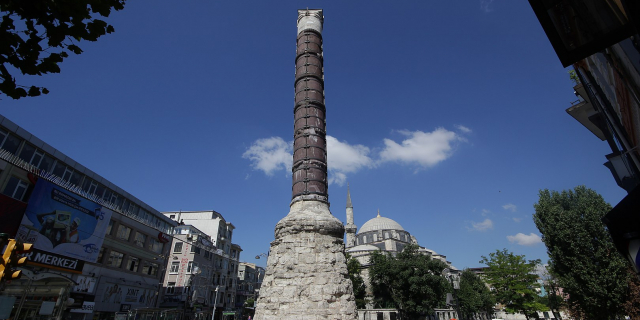













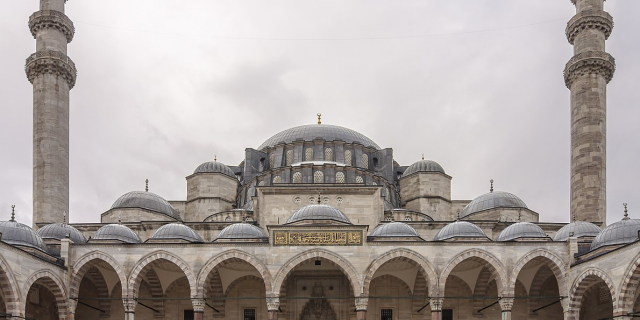











Add new comment